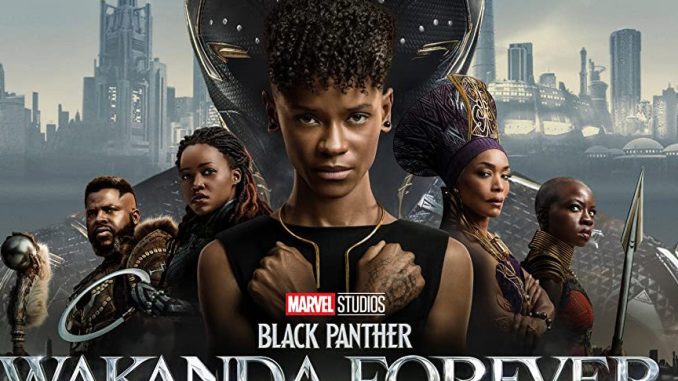
By Kaylin Guzman
“Black Panther: Wakanda Forever” hit theaters and fans’ hearts on Nov. 11. After the unexpected death of Chadwick Boseman in 2020, the future of Marvel’s Black Panther was in question. Although executives from Marvel knew they would not recast the character, fans of the franchise had high expectations of the sequel that would signal the end of Boseman’s reign as the titular superhero.
If you have not watched the movie, this review will contain spoilers and should be avoided if you want to experience the film to its full potential.
With an abrupt start, the movie explains T’challa’s death. News sources within the Marvel Cinematic Universe even say the death occurred due to an undisclosed disease. It was a respectful way to signal Boseman’s death without taking advantage of the situation surrounding his passing. With a funeral held for the fallen king, we get a glimpse of African traditions and their experience with death. While many question why T’challa’s funeral was not attended by his superhero counterparts, it is their presence in these scenes that would have been a distraction from the purpose of the opening act.
This act was a goodbye to T’challa as king and protector of Wakanda. Audiences were allowed to have a moment to reflect on the loss of a beloved character and the actor that beautifully brought him to life.
The sequel is arguably one of the most authentic Marvel films after “Avengers Endgame.” Since Marvel has been focusing on quantity over quality lately, it was nice to see they did not rush this movie and ensured the plot made sense to the character development. From small details in the new Black Panther suit to the explanation of new personas introduced to the MCU.
Two of the most critical characters introduced were Namor (Tenoch Huerta) and Riri “Ironheart” Williams (Dominique Thorne), who make the new story explored throughout the film. After T’challa opened the borders of Wakanda to the world, all world powers wanted to have a little bit of vibranium in their possession. Vibranium is the type of metal found in Wakanda and parts of the ocean. This material has allowed both civilizations to become significantly advanced compared to other nations in the MCU.
Williams, a brilliant young woman attending M.I.T., creates a machine that can detect vibranium, creating problems for Wakanda and its precious resource. Her invention was taken by United States officials and used to find small deposits of the resource deep within the seafloor. However, these deposits are not located near Wakanda, where the only deposits were believed to be. Instead, they are found in the vast oceanic kingdom of Talokan, where the first battle for underwater vibranium begins. To defend their precious metal, Talokan warriors take it upon themselves to fight against the invading military forces.
From this point on, Namor and his people are trying to defend their homes and precious resources. We get an origin story for Namor, “El Niño Sin Amor,” and how he became the leader of the underwater Talokan kingdom. He is established to be a mutant, the second in the current MCU after Kamala Khan from the Disney+ series “Ms. Marvel.”
The city of Talokan, hidden deep within the water’s darkness, seems ancient but technologically advanced. Its people have assimilated to its environment and have developed like its above-water counterpart, Wakanda.
The incorporation of ancient Mesoamerican culture was exciting on its own. Audiences got to see art from that era and hear the native tongue spoken amongst characters. The production team’s attention to detail even led them to color-coordinate subtitles for the different languages spoken so viewers could differentiate. Wakandan is always in yellow, the language of Talokan is blue, and any other language present needing translation is white.
Never before had I seen a film embrace such a forgotten culture as this film did. Representation is essential for every culture shoved down to the bottom of the barrel. The way the writers and directors of the film decided to display this Mesoamerica-inspired city and its people was remarkable. I hope this is not the last we see of Namor, “El Niño Sin Amor.”
My system of knowing a movie is good depends on how many times it can make me cry. I cried three times during “Wakanda Forever” since some scenes called for tears to be shed. From T’challa’s funeral, the death of another central character, the introduction of the new Black Panther, and the grief beautifully explored in this film. Director Ryan Coogler truly delivered a fantastic experience to audiences. Although an unexpected journey for the characters such as Shuri, Queen Ramonda, and Nakia.
Nakia lost the love of her life. Queen Ramonda lost her son, a crucial part of her life and Wakanda. While Shuri follows in her brother T’challa’s footsteps and takes over the Black Panther role. Her suit displays silver and gold parts, exploring her persona and how she has been influenced by other characters. Silver was the prominent color of T’challa’s suit. Gold was the color of Killmonger’s suit, who was the vengeful cousin looking to right the wrongs done to his father when he was younger.
The new titular superhero goes through the five stages of grief, and the audience is along for the ride. It was interesting to see her attitude throughout the movie change.
I believe this narrative leaves the characters, like Shuri, in an excellent place for the future. They are open-ended characters that can develop in any way possible. Whether Shuri uses her skills for good or bad is up to Marvel. This is why ‘Black Panther: Wakanda Forever’ was the perfect way to end the MCU’s phase four.
